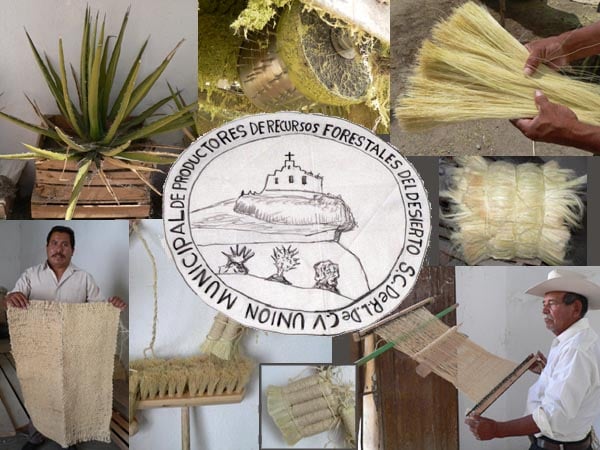(galleries) |
No edit summary |
||
| Line 12: | Line 12: | ||
:The lechuguilla is currently harvested from the wild rather than farmed. While this might be very appropriate for a certain amount of production, it could cause problems with the ecosystem in the surrounding area if the wild plants are over-harvested for greatly increased production. | :The lechuguilla is currently harvested from the wild rather than farmed. While this might be very appropriate for a certain amount of production, it could cause problems with the ecosystem in the surrounding area if the wild plants are over-harvested for greatly increased production. | ||
[[Image:Lechuguilla.jpg]] | [[Image:Lechuguilla.jpg]] | ||
===AltMat Bucket Retriever for Well=== | ===AltMat Bucket Retriever for Well=== | ||
| Line 58: | Line 57: | ||
===Carrizo Roof=== | ===Carrizo Roof=== | ||
;Description :Bamboo, or carrizo, is a building material that is traditionally used in Mexico as part of the roof of an adobe house. | ;Description :Bamboo, or carrizo, is a building material that is traditionally used in Mexico as part of the roof of an adobe house. | ||
Revision as of 13:38, 24 November 2018
Parras Lechuguilla
- Description
- Lechuguilla is an excellent example of an alternative material. Lechuguilla is used instead of synthetic or animal products to make rope, brushes, brooms, matts, etc.
- Location
- On Ramos Arizpe, behind a huge metal gate. Look in, and if you see a short dirt road leading to an open arch door, you're at the right place.
- Justification
- Lechuguilla is a locally harvested material that is used by local workers. It does not pose the human health hazards that synthetic materials do, and does not create the waste and moral issues that animal products do.
- Issues
- The lechuguilla is currently harvested from the wild rather than farmed. While this might be very appropriate for a certain amount of production, it could cause problems with the ecosystem in the surrounding area if the wild plants are over-harvested for greatly increased production.
AltMat Bucket Retriever for Well
- Description
- This is an example of all-natural and reused materials. It's a huge log with a reused bar stuck into it for a handle. It's used in a wind-pumped well to retrieve buckets of trash when it needs to be cleaned.
- Location
- Located on a Nogales orchard underneath one of the wind pumps on someone's property north of town.
- Justification
- This reduces waste by reusing materials, and is a better choice for the environment than synthetic or new materials.
- Issues
- Depending on where the log came from, it could be contributing to deforestation.
AltMat Fence
- Description
- This is an example of alternative materials. It's a fence made out of scrap wood instead of new lumber.
- Location
- Located on the border of a Nogales orchard on someone's property north of town.
- Justification
- This is appropriate because it is reusing local materials that were already lying around. It helps cut back on the use of new wood. It is also much more visually pleasing.
- Issues
- Wood deteriorates over time, so the fence will have to be replaced sooner than if a stone wall or metal fence was used instead. Also, since each piece of wood is very unique, the strength at different places on the fence probably varies. However, since all the pieces of wood are fairly large, there may not be a problem with the fence being too weak at any given spot.
Carrizo Roof
- Description
- Bamboo, or carrizo, is a building material that is traditionally used in Mexico as part of the roof of an adobe house.
- Location
- Carrizo is found growing along waterways in Parras, such as arroyos and asequias (channels flowing from the estanques)
- Justification as Appropriate
- Carrizo is an appropriate building material because it is a local, inexpensive and renewable resource, and because building with it leverages this community's existing knowledge
- Issues with the Appropriateness
- Althogh bamboo is touted as an environmentally friendly building material, in dry climates there is another issue to consider. Carrizo needs a lot of water, and it can significantly reduce the water flow through the channels and streams in desert areas.
Instructions
To add a new AT implementation to this resource, Copy and paste the following into notepad. Make the appropriate edits (replace allcap text) and then paste above the Instructions line in the edit window. Template:Parras AT













